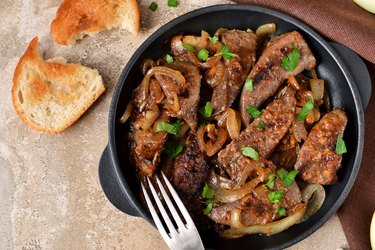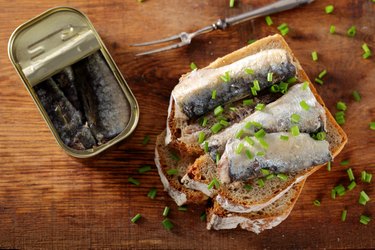If you've ever experienced the painful flares of gout, it makes sense that you want to find a way to avoid future attacks as much as possible. Your doctor may even recommend cutting down on high-purine foods or getting more exercise.
Gout is a type of arthritis characterized by immediate and intense attacks of pain, discomfort, inflammation and swelling in the joints, according to the Centers for Disease Control and Prevention (CDC). Symptoms usually occur in the big toes but can also affect other joints like the ankles, knees, elbows and wrists.
Video of the Day
Video of the Day
Gout occurs when uric acids build up in your body and cause crystals to form in your joints. Uric acid is produced when organic compounds called purines are broken down in your body, according to the Mayo Clinic.
Typically, your body excretes uric acid through urine, but the problem arises when there's too much uric acid that builds up in your blood and forms crystals in the body.
Limiting foods high in purines may reduce your uric acid levels and help prevent future gout attacks, per a September 2017 review in the Journal of Advanced Research. So, you may want to avoid animal-based purine-rich foods such as organ meats, seafood and red meats.
How Much Purine Should You Eat?
The American College of Rheumatology does not specify a limit on purines. In Japan, people with gout or high uric acid levels (above 6 milligrams per deciliter) are advised to take in less than 400 milligrams of purines per day, per a February 2014 analysis in the Biological and Pharmaceutical Bulletin.
Drinking low-fat milk can reduce uric acid levels in your body because the proteins in milk help your body get rid of uric acid through urine. Even though some vegetables are high in purines, eating them doesn't seem to increase the amount of uric acid in the body, according to a June 2012 study in the journal PLOS ONE.
On the other hand, you may want to avoid or limit sugar-sweetened beverages and alcohol that can increase uric acid in your body. Beer, liquor and soda are especially notorious triggers for gout flares.
Find out what foods are high in uric acid and purines below, per the Biological and Pharmaceutical Bulletin report, so that you know what to limit if you have gout.
1. Chicken Liver: 312.2 mg

All organ meat is high in purines, whether it comes from pork, beef or chicken. Chicken liver offers 312.2 milligrams of purines in a 3.5-ounce serving.
Instead, opt for chicken breast, wings and drumsticks, which are all considered moderate-purine foods.
2. Anchovies: 303.9 mg
People either love anchovies or hate them, but one thing is for sure: Anchovies are rich in purines, with 303.9 milligrams per 3.5-ounce serving, according to a November 2020 study in Nucleosides, Nucleotides & Nucleic Acids.
Anchovies are also high in sodium, providing 153 percent of the DV per 3.5 ounces canned.
3. Shrimp: 273.2 mg
Although the dietary cholesterol in shrimp does not negatively affect your blood cholesterol as was once believed, you may still want to avoid them if you're limiting your purine intake. A 3.5-ounce serving of shrimp contains 273.2 milligrams of purines.
You may want to consider swapping shrimp for lower-purine shellfish like lobster or crab. These options are still technically considered high-purine foods, but they have considerably less purine than shrimp. Lobster has 102 milligrams of purines and crab has 152 milligrams per 3.5-ounce serving.
4. Sardines: 210.4 mg

Like other seafood on this list, sardines are high in purines. A 3.5-ounce serving of sardines contains 210.4 milligrams of purines.
On the flip side, sardines are low in mercury and high in the healthy omega-3 fatty acids EPA and DHA. The Arthritis Foundation recommends fatty fish rich in omega-3s a couple of times a week because of their anti-inflammatory benefits.
5. Oysters: 184.5 mg
Oysters may be known for their aphrodisiac qualities, but you might want to reconsider shucking them if you're at risk of gout. A 3.5-ounce serving has 184.5 milligrams of purines. Oysters are part of the shellfish family, and shellfish are known for their high purine content.
6. Rainbow Trout: 180.9 mg
Like sardines, rainbow trout is another fish high in omega-3 fats that is also high in purines. There are 180.9 milligrams of purines in a 3.5-ounce serving of rainbow trout.
Try swapping trout for fish with slightly fewer purines, such as halibut, sea bass or carp.
7. Beef Kidney: 174.2 mg

If you've been advised to avoid or limit intake of red meat like beef to reduce the recurrence of gout attacks, it's for a good reason: Beef (especially beef kidney) is a high-purine food. You'll get 174.2 milligrams of purines in a 3.5-ounce serving of beef kidney.
8. Pork Tenderloin: 119.7 mg
Pork may be a lean protein option, but that doesn't mean you should eat it liberally if you're trying to avoid gout flares. A 3.5-ounce serving of pork tenderloin contains 119.7 milligrams of purines.
If you'd like to enjoy pork with less purine, try lower-purine cuts instead, like ribs, shoulder and sirloin.
Foods High in Purines Chart
Food | Purine Content (per 3.5 oz.) |
|---|---|
Chicken Liver | 312.2 mg |
Anchovies | 303.9 mg |
Shrimp | 273.2 mg |
Sardines | 210.4 mg |
Oysters | 184.5 mg |
Rainbow Trout | 180.9 mg |
Beef Kidney | 174.2 mg |
Pork Tenderloin | 119.7 mg |
- CDC: "Gout"
- Mayo Clinic: "Gout"
- Journal of Advanced Research: "Gout: An old disease in new perspective – A review"
- Arthritis Foundation: "Gout Diet: Dos and Don’ts"
- Arthritis and Rheumatology: "2020 American College of Rheumatology Guideline for the Management of Gout"
- Biological and Pharmaceutical Bulletin: "Total purine and purine base content of common foodstuffs for facilitating nutritional therapy for gout and hyperuricemia"
- PLOS ONE: "The Association of Dietary Intake of Purine-Rich Vegetables, Sugar-Sweetened Beverages and Dairy with Plasma Urate, in a Cross-Sectional Study"
- Arthritis Foundation: "Best Fish for Arthritis"
- Nucleosides, Nucleotides & Nucleic Acids: "Measurement of the total purine contents and free nucleosides, nucleotides, and purine bases composition in Japanese anchovies (Engraulis japonicus) using high-performance liquid chromatography with UV detection"